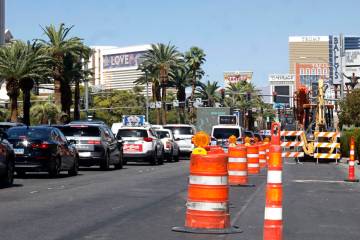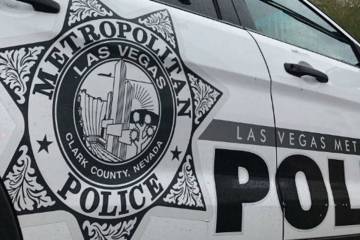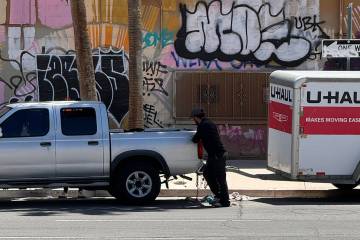Audit raises questions about taxicab medallion regulation
In October 2009, a Las Vegas taxi company reported one of its medallions missing and picked up a replacement. Fifteen months later, same company, same problem, same outcome.
Yet during an inventory last year, according to a Legislative Counsel Bureau audit report, the Nevada Taxicab Authority found that the unidentified company actually had the medallion originally said to have gone AWOL.
What’s the big deal?
By the audit calculation, each medallion generates $190,000 a year in revenues for the company that holds it.
In this case, the audit determined that the company held the replacement medallion for 14 months before returning it, good for an extra $2.7 million.
Medallions, which look like miniature license plates, act as operating permits; they must be on the taxi to allow the driver to pick up fare-paying passengers legally. A primary function of the authority is to mete out medallions among the 16 companies and then keep track of them afterward.
The audit report published in April caught the most attention for its conclusion that close to a fourth of the rides from McCarran International Airport to Strip hotel-casinos in its sample were long hauls, in which drivers take circuitous routes to run up the fares. Based on that, the audit “conservatively estimated” that visitors had been bilked $14.8 million last year.
But the sections pertaining to medallion regulation drew little public notice, even though they have generated heated debate within the industry for the past two years. People attending the monthly taxi authority meetings now must empty their pockets and pass metal detectors because of angry outbursts during debates over medallions, and the issuance of new permanent medallions in August 2011 loomed as a large issue in the two-month drivers strike against Yellow Checker Star Transportation and the wildcat walkout against Frias Transportation Management.
To the drivers, medallion distribution embodies all of their complaints about deteriorating pay and working conditions. After years of abundant growth, taxi travel took a hit during the recession; the number of trips fell 11 percent from 2007 to 2009. This matters because drivers are paid a percentage of what they collect minus certain expenses, all of which vary by company. By drivers’ testimonials, tourists became stingier with tips, too.
But when the number of trips rebounded to a record 27 million in 2011, the companies pressed for and won new permanent medallions. Managers argued that they needed extra capacity to meet the surging demand and not lose market share to competitors such as limousines.
As the audit noted, the medallions led to driver protests about diluted income and too many cabs on the streets, especially when the companies come in for temporary medallions for big-draw events such as the International CES convention or the Electric Daisy Carnival music festival. And drivers saw companies earning extra income that did not filter back to them in pay raises, leading to the work disruptions.
The auditors recommended an overhaul for allocating the medallions, now numbering 2,410, including those limited by time, day and geographic restrictions. Rather than focus on historic factors such as trip counts, gross revenue, airport passenger projections and hotel occupancy rates, the auditors argued, staff analysis should pay closer attention to passenger wait times in popular locations and peak times. This could mean poring over the trip sheets filled out by drivers.
Furthermore, the argument went, the medallions need to be tracked much more tightly in line with procedures in place for several years. This includes issuing a fresh set of medallions to each company annually after the old ones are turned in; the authority has not issued new medallions since 2006.
The expense would run only about $4,000, the audit said, because the medallions are stamped out in state prisons at $1.33 each.
An inventory completed in March 2012 turned up numerous discrepancies between authority records, including one unidentified company on the books for 60 medallions but holding 67. In all, companies produced 18 medallions that had been reported as stolen or lost.
To crack down, the audit recommended “a graduated and equitable system of sanctions” applied to the companies. Current law permits fines of up to $15,000 per violation.
To some extent, the authority is paying the price for years of being a government backwater, with frequent turnover on the board and among top management. The situation has stabilized in the past couple of years.
Although authority administrator Charles Harvey promised a comprehensive response in the next few years, including the parts about long-hauling, he sent the auditors a preliminary report in early April. Included in the points were plans to redesign its calculus for determining medallion needs, a new medallion database, another physical inventory in the fiscal year starting July 1 and regular medallion rotations.
Authority staff will start spot inspections of medallions to ensure they are placed in the correct location on cabs.
• • •
In case you hadn’t noticed, flying is getting better.
Research firm J.D. Power & Associates scored customer satisfaction with airlines at the highest level since 2006. Improvement by what Power calls traditional airlines, such as Delta and Alaska, rose faster than it did in Powers’ low-cost category, which includes Las Vegas market leader Southwest.
Results also show fewer passengers are downgrading carriers because of bag fees: 37 percent now say the fees are reasonable, double the number just two years ago.




























